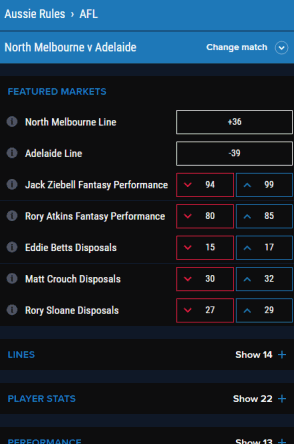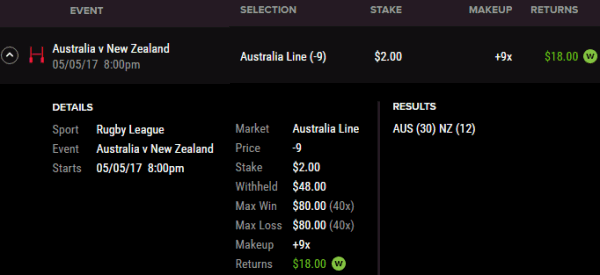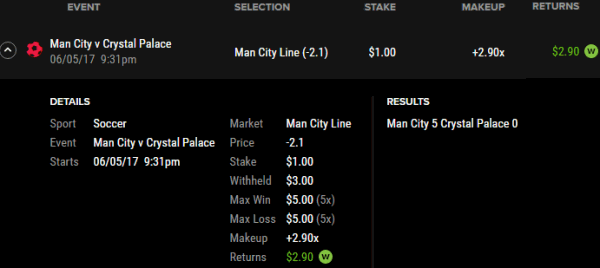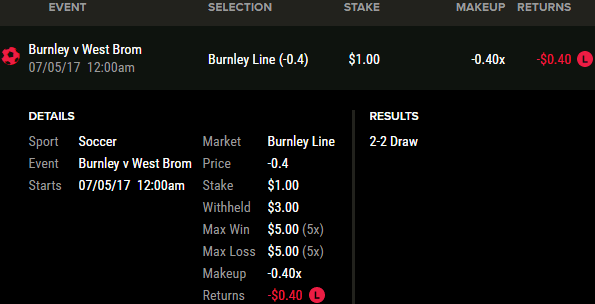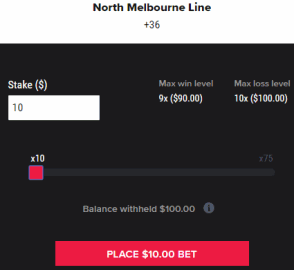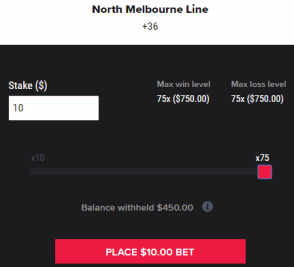You are here: Home >> Beginner’s Guide >> Other Betting Options >> Spread Betting
Spread betting, also known as index betting, is a form of wagering that pays a variable amount depending on the accuracy of your prediction compared to the bookmaker’s spread. This in contrast to a fixed odds bet that pays a set amount if a certain criterion is met.
With a traditional bookmaker most sports bets will have one of two outcomes: you either win at predetermined odds (e.g. 1.91), or you lose your stake. There are other scenarios too in Asian handicap betting, but with any given wager you can’t lose more than your stake.
With spread betting, however, how much you win or lose depends on the margin by which you bet wins or loses. The payout equals the stake multiplied by the difference between the result and your chosen line or total. The bookmaker will temporary hold an amount greater than you stake from your account until the bet is concluded. This is to ensure there are sufficient funds in your account to settle the bet in the event of a heavy loss.
The best way to illustrate spread betting is to provide examples. To the right is a screenshot of markets for an AFL game.
With a traditional line bet a bookmaker margin is built into the odds, which is how bookmakers make a profit. If a bet is supposed to have a 50% chance of winning, instead of offering 2.00 odds, the bookmaker will offer around 1.91 odds.
With spread betting there are no odds. Instead the bookmaker obtains a profit by offering different lines/totals on each option. The gap between the the two lines or totals is called the spread, which is the difference between the “under” and “over” or the difference between the “plus line” and “minus line” on each market. For AFL lines the spread is typically 3 points, while for a low scoring sport like the English Premier League the spread is typically 0.2 goals.
In the sample AFL fixture you could bet on North Melbourne +36 or Adelaide -39. In this market the spread is 3 points. If Adelaide wins by 20 points then the North Melbourne bet would return 16x (16 times) the stake amount, while those who backed Adelaide would lose 19x their stake amount. As with traditional betting, the losers lose more than the winners win, which is how the bookmaker finances its services.
Note that if Adelaide won by 37 or 38 points then the players who backed North Melbourne +36 or Adelaide -39 would all lose.
In addition to lines, you can also wager on the total score, various match statistics and numerous individual performance markets.
You can also wager on “Time Of” markets, where you bet on whether you believe a certain game event or milestone will be reached before or after a specified time.
Example 1 – winning rugby league wager
Below is a concluded wager with the Australian spread betting operator PointsBet. The fixture is a ANZAC rugby league Test between the Kangaroos and Kiwis. A wager of $2.00 was placed on the Kangaroos at -9.0. The max win/loss was set at 40x. This means the maximum the bet could have lost was 40 x $2 = $80 and the maximum possible win was 40 x $2 = $80.
The final score was 30-12, so the Kangaroos won by 18 points. The final margin is 9 points beyond the -9 line, so the bet returns the difference, multiplied by the stake: 9 x $2 = $18.
At first glance this looks like a return of $18 from a $2 wager, but remember that $48 was withheld from the account balance for this bet and the maximum possible loss was $80.
Example 2 – winning football wager
The following bet is a $1 wager on Manchester City -2.1 goals vs. Crystal Palace. The -2.1 bet returns a win if Man City win by more than 2.1 goals and returns a loss if they win by fewer than 2.1 goals, draw or lose the game.
Note that the risk level for this wager is far less than the rugby league bet due to the nature of the sport. The maximum win/loss levels are 5x instead of 40x for the rugby league wager.
The final score was 5-0, so the winning margin was 5 goals. The bet returned $1 * (5 – 2.1) = $2.90.
Example 3 – losing football wager
The following is a bet on Burnley -0.4 goals vs West Brom. For the bet to win Burnley needed to win by one goal or more. A draw or a defeat would result in a loss.
The game resulted in a 2-2 draw, so the final margin was 0. The bet returned $1 * (0 – 0.4) = -$0.40. Note that for this particular bet the loss of $0.40 is less than the stake amount of $1.00.
Varying the risk level
For volatile markets you can often choose your risk level prior to placing a bet.
The following two images show potential bets on the same selection in the same market, but with different risk settings:
In the first screenshot the risk setting is 10x. For a stake of $10 the maximum possible loss is $100 and the maximum possible win is $90. Note that the system would withhold $100 from your account balance until the bet is concluded.
In the second screenshot the risk setting is 75x. For a stake of $10 the maximum possible loss is $750 and the maximum possible win is $750. In this case the system would withhold $450 from your account balance until the bet is concluded. Note that unlike the minimum risk wager, the amount withheld is less than the maximum possible loss because the system has determined that a loss beyond 45x is unlikely.
The above examples show the two extremes for that particular wager. Every option in-between is also available: 11x, 12x, 13x, etc. You can set the risk level based on how much risk you want to take on and the amount you have available in your account balance.
Strategy also comes into it. Someone who believes North Melbourne will cover the line, but only by a small margin, might opt for a higher stake and a lower max/min loss level. This would return a greater profit provided the team doesn’t go beyond the win limit, because a higher stake was wagered. Conversely, someone who believes the team will cover the line easily might opt for a lower stake and a higher max/min loss level. They feel the lower win limits will come into play, and it would be frustrating to have the final margin be, say 30 points beyond the line, but have the win capped at 10x.
When participating in spread betting, keep in mind the following advice:
- Always remember that you may lose more than your original stake
- Establish what the realistic worst case scenario is for the bet and factor this in when choosing your stake
- Recognise that some markets are more volatile than others (e.g. AFL winning margins can be substantial compared to soccer)
- When betting on volatile markets, use the “Stop Loss” feature to set the risk to a level that you’re comfortable with
Spread betting calculator
This online PointsBet Spread Betting Calculator determines the impact of the maximum loss setting on payoffs for spread bets. The calculator is specific to the Australian-licensed spread betting bookmaker PointsBet.
Cash only accounts vs. credit accounts
Members can elect to have either a cash only account or a credit account. The cash only account is provided by default. The credit account comes with a “Deferred Settlement betting facility”, where you have to top up your account if your balance goes into the negative beyond a pre-determined limit. The upside of a cash account is you will not owe PointsBet money if your account goes into the negative. The upside of a credit account is PointsBet will withhold a smaller amount of funds for each bet, so you can place more bets with larger stakes with the same account balance.
What happens in the event of a negative account balance?
It depends on your account type and the spread betting operator. The following are the policies at PointsBet:
If you hold a cash only account and your account goes into negative, if you wish to continue betting you will need to redeposit. Alternatively, PointsBet will return your account to a $0 balance within 24 hours.
If you hold a credit account and your account goes into a negative value of greater magnitude than your Deferred Settlement Facility Limit, if you wish to continue betting you will need to redeposit.
If your account is consistently going into a negative balance, PointsBet may at their discretion increase your withheld amount to 100% of the Max Loss amount of the market you are betting on.
Spread betting in Australia
Spread betting was previously offered by Sports Alive until it went into voluntary liquidation in August, 2011.
In early 2017 PointsBet was launched and is currently the only Australian-licensed spread betting provider in Australia.
Visit the PointsBet website
View our PointsBet review
|
<< Previous topic: Flexi Betting |
Next topic: Live ‘In-Play’ Betting >> |

